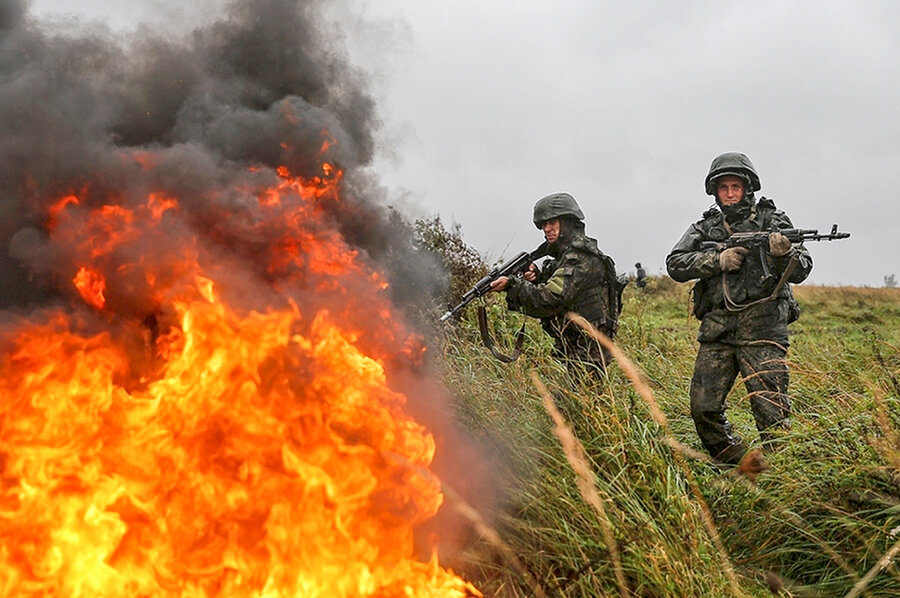
World BEYOND War Factsheet
The ecological footprint of war and ongoing preparations for war cannot be ignored. Militarism is a top contributor to the global climate crisis and a direct cause of lasting environmental damage. And yet military activities are often exempted from key environmental regulations, such as the Kyoto Protocol. (1)
A Thirst for Oil
A major motivation behind war is the desire to control resources, especially oil and gas. In fact, foreign military intervention in civil wars does not correlate with human rights violations, lack of democracy, or threats of terrorism, but does strongly correlate with the presence of oil. Third-party intervention in a civil war is 100 times more likely when the country at war has large reserves of oil. (2)
Carbon Cost
The US military is one of the biggest polluters on Earth. Since 2001, the US military has emitted 1.2 billion metric tons of greenhouse gases, equivalent to the annual emissions of 257 million cars on the road. (3)
The US Department of Defense is the largest institutional consumer of oil ($17B/year) in the world, and the largest global landholder with 800 foreign military bases in 80 countries. (4)
By one estimate, the US military used 1.2 million barrels of oil in Iraq in just one month of 2008. (5) One military estimate in 2003 was that two- thirds of the US Army’s fuel consumption occurred in vehicles that were delivering fuel to the battlefield. (6)
Poisoned Water
The US military is among the top three largest polluters of US waterways. It dumped 63,335,653 pounds of poison into waterways from 2010-2014, including carcinogenic and radioactive chemicals, rocket fuel, and toxic sewage. (7)
A Pentagon Report released in 2018 details widespread chemical poisoning of water supplies on military bases and in surrounding communities worldwide. (8) The report identifies the presence of PFOS and PFOA chemicals in drinking water at levels known to be harmful to human health and linked to cancer and birth defects.
At least 401 bases are known to have contaminated water. PFOA and PFOS chemicals are used in re retardants during routine re- training exercises on US military bases worldwide.
The majority of “Superfund” sites in the US are current or former military-related installations, sites designated by the US Environmental Protection Agency where extreme hazardous waste threatens human health and the environment. (9)
Traces Left Behind
The most deadly weapons left behind by war are landmines and cluster bombs. A 1993 US State Department report called landmines “perhaps the most toxic and widespread pollution facing mankind.” (10) Millions of hectares in Europe, North Africa, and Asia are under interdiction because of tens of millions of landmines and cluster bombs left behind by war.
In Libya, one-third of its land mass is considered contaminated by landmines and unexploded munitions from World War II. “Land mines accelerate environmental damage through 1 of 4 mechanisms: fear of mines denies access to abundant natural resources and arable land; populations are forced to move preferentially into marginal and fragile environments in order to avoid minefields; this migration speeds depletion of biological diversity; and landmine explosions disrupt essential soil and water processes.” (11)
Intentional Damage
Compounding the massive ecological footprint of war and ongoing preparations for war, damage to the environment is also a deliberate tactic used in warfare, such as the destruction of forests, farms, and irrigation systems during World War II.
From 1965 to 1971, the US sprayed 3,640 km2 of southern Vietnam with dangerous herbicides and defoliants, including the infamous Agent Orange. During the Gulf War, Iraq released 10 million gallons of oil into the Persian Gulf and set 732 oil wells on re, causing extensive damage to wildlife and poisoning groundwater with oil spills. (12)
Militarism is a top global polluter and a leading contributor to the climate crisis, yet it is often exempted from key environmental standards.
References
(1) Lorincz, Tamara. “The Climate & Environmental Impacts of the Canadian and American Militaries.” How War Threatens the Environment Webinar, 27 September 2018. Powerpoint Presentation.
(2) Bove, V., K.S. Gleditsch, and P.G. Sekeris. “Oil above Water: Economic Interdependence and Third-party Intervention.” Journal of Conflict Resolution, 2015. https://doi.org/10.1177/0022002714567 952.
(3) “Summary: Pentagon Fuel Use, Climate Change, and the Costs of War.” Costs of War, 12 June 2019, https://watson.brown.edu/costsofwar/ les/cow/imce/papers/2019/Summary_Pentagon%20Fuel%20Use%2C%20Climate %20Change%2C%20and%20the %20Costs%20of%20War %20%281%29.pdf.
(4) Lorincz, Tamara. “The Climate & Environmental Impacts of the Canadian and American Militaries.” How War Threatens the Environment Webinar, 27 September 2018. Powerpoint Presentation. “US Military Bases Overseas: The Facts.” Overseas Base Realignment and Closure Coalition, 27 November 2018, https://www.overseasbases.net/fact-sheet.html.
(5) Associated Press. “Facts on Military Fuel Consumption,” USA Today, 2 April 2008, http://www.usatoday.com/news/washington/2008-04-02-2602932101_x.htm.
(6) Conover, Joseph, Harry Husted, John MacBain, and Heather McKee. “Logistics and Capability Implications of a Bradley Fighting Vehicle with a Fuel Cell Auxiliary Power Unit.” SAE World Congress, March 2004, Detroit, MI. SAE Technical Papers Series, 2004-01-1586. https://doi.org/10.4271/2004-01-1586.
(7) Urry, Emerson. “The Department of Defense Is the Third Largest Polluter of US Waterways.” Truthout, 15 February 2016, https://truthout.org/articles/the-department-of-defense-is-the-third- largest-polluter-of-us-waterways/.
(8) Sullivan, Maureen. “Addressing Per-uorooctane Sulfonate (PFOS) and Per uorooctanoicAcid (PFOA).” Department of Defense, March 2018, https://www.denix.osd.mil/derp/home/documents/pfos-pfoa-briefing-to-the-hasc/.
(9) Nazaryan, Alexander. “The US Department of Defense Is One of the World’s Biggest Polluters.” Newsweek, 17 July 2014, https://www.newsweek.com/2014/07/25 /us-department-defence-one-worlds- biggest-polluters-259456.html.
(10) US Department of State. “Hidden Killers: The Global Problem with Uncleared Landmines.” US Department of State, 1993.
(11) Leaning, Jennifer. “Environment and health: 5. Impact of war.” CMAJ: Canadian Medical Association Journal, vol. 163, no. 9, 2000, pp. 1157-61.
(12) Ibid.
Learn more at: worldbeyondwar.org/environment
World BEYOND War is a global grassroots network of volunteers, activists, and allied organizations advocating for the abolition of war and its replacement with an alternative global security system based on peace and demilitarization. Visit WorldBEYONDWar.org to join the global movement to end all wars.